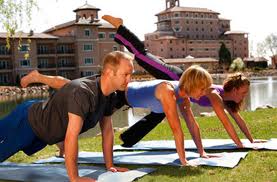Body weight exercises are very useful and should be part of a complete workout routine. However, too many people focus on lifting weights and forget the many benefits that training with your body weight can provide.
Granted, body weight exercises cannot provide the same kind of stimulus for the muscles as heavy loaded barbells do. This does not mean that they do not have a place in your weight training routine. It could be part of your warm-up or cool-down routine, or it could be included as a light activity during your active recovery days. If you are using body weight exercises this way, you should stay at least five repetitions away from your maximum reps to avoid tiring out your muscles and interfering with recovery.
Another way to use body weight exercises is to make them assistance movements. For example, on push day, you can do push-ups as assistance to the bench press and body weight squats as assistance to barbell squats. On pull day, you can use pull-ups instead of barbell rows to complement the dead lift. As assistance movements, you should be going only one repetition short of your maximum so that you don’t fry your central nervous system but still get good training effects.
Finally, if you are not a competitive power lifter, you can dedicate whole training sessions to doing just body weight exercises. For instance, if you did a heavy session on Monday, you can do a body weight session on Tuesday, have a rest day doing just abs on Wednesday, and do weights again on Thursday and body weight on Friday and Saturday. Sundays are just for rest.
Proper form is essential even with body weight exercises. The risk for injury is still there, and since you do a lot of repetitions, bad form can easily become a habit after some time.
You can get very creative with how you do body weight exercises, but there are a few “base” movements that you need to master before you can experiment with other variations.
Push-up
The push-up is one of the most commonly used measures of upper-body strength. It works mainly the chest and triceps. To make it more difficult, you can elevate your feet so that your arms are supporting more weight. You can also raise one foot off the floor, or do both. For the advanced trainees, handstand push-ups are very good for the triceps, but places more emphasis on the shoulders than the chest.
Pull-up
Along with the push-up, this is another very common measure of upper-body strength. It targets the biceps, shoulders, and the upper back muscles. Once you reach twenty repetitions using just body weight, you can start adding weight to make the exercise more challenging. You can even attempt to do one-arm pull-ups down the road. Or you can do muscle-ups – pull yourself up explosively and push yourself up above the bar.
Squat
The body weight squat is more of a conditioning exercise since the leg muscles need a lot of weight to get very strong. This does not mean doing them without weight is useless – instead of doing endless repetitions, you can do jumping squats, or one-legged squats.
Lunges
These work the thigh muscles very well, ensuring a balance between your left and right leg.
Finally, incorporating single leg, single arm and alternating movements will help with establishing balance as well as symmetry throughout your body. This will not only provide great overall strength gains but also dramatically increase core-stability as well.











